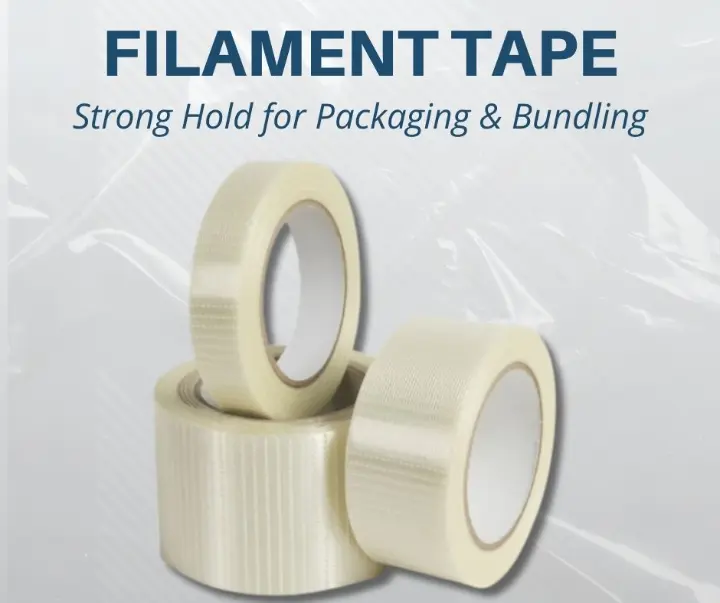
In today’s fast-paced supply chains, one packaging product is quietly reshaping how companies seal, secure, and ship: filament tape. Once seen as a niche solution, it is now a mainstream choice across FMCG, pharma, e-commerce, and logistics. This shift reflects wider industry trends in packaging automation, cost optimization, and export readiness.
Let’s explore why filament tape is gaining ground, where it fits best, and how Gujarat industries are adopting it as a strategic consumable.
Why Filament Tape is Outpacing Traditional Options
Markets are moving away from generic carton tape and even steel strapping in certain mid-load applications. Here’s why:
Strength Meets Flexibility: Reinforced with glass filaments, it offers tensile strength up to 300–450 N/25 mm, holding power far beyond ordinary BOPP tape.
Residue-Free & Audit-Friendly: Hotmelt or synthetic rubber adhesives provide aggressive bonding yet peel clean on corrugated, keeping pharma and FMCG audits smooth.
Lighter Than Steel: While PET or steel straps demand tools, filament tape applies faster and safer, reducing handling injuries.
Export Ready: With temperature resistance (~-20°C to 80°C) and long shelf life, it survives monsoon yards and cold-chain lanes without losing bond.
As global buyers push for cleaner, faster, safer packaging, filament tape ticks all three boxes.
Industry Trend #1: E-Commerce Drives Tamper Security
E-commerce fulfillment centers in Gujarat are among the biggest adopters. Each parcel must be tamper-evident, quick to process, and cost-efficient. Filament tape, especially cross-weave grades, creates a visible seal that deters resealing while withstanding rough courier handling.
“After switching to cross-filament tape, our return disputes dropped by 14% in one quarter. Customers saw the seal as a trust mark,”
— Operations Lead, Vadodara E-Com Hub
Industry Trend #2: Pharma Packaging Standardization
Pharmaceutical exporters must comply with international carton integrity and sealing standards. Buyers demand seals that don’t lift in transit or leave residue that can trigger audits. Filament tape, available in widths from 12 mm to 48 mm, is becoming a standard secondary sealing material for shipping cartons and bundling lightweight packs.
In fact, many QA teams now prefer filament tape over generic brown tape for outbound cartons bound for Europe and North America.
Industry Trend #3: FMCG Seeks Faster Turnaround
In FMCG, speed at dispatch bays is everything. Filament tape applies faster than PET strapping and avoids tool maintenance. Cartons sealed with filament tape pass stacking and compression tests, making them reliable for short-haul and regional distribution.
With machine-compatible rolls (48–72 mm × 50–1000 m), filament tape integrates into automated case sealers—a trend accelerating as Gujarat co-packers scale throughput.
Industry Trend #4: Logistics Looks Beyond Strapping
3PL warehouses and exporters are reducing strapping SKUs by shifting some medium-load applications to filament tape. A 19 mm reinforced filament tape can secure bundles of cartons, small appliances, or spare parts with less labor and safer handling than steel strap.
This change is not just about material savings; it’s about simplifying SOPs and reducing injury claims.
Specs That Support These Trends
Widths: 12, 18, 24, 36, 48, 72 mm
Thickness: ~130–160 µm (grade dependent)
Adhesives: Hotmelt synthetic rubber (high tack), solvent rubber (temperature endurance)
Tensile Strength: ~300–450 N/25 mm for uni-directional; ~500–600 N/25 mm for cross-weave
Temperature Window: -20°C to 80°C
Shelf Life: 12 months in dry, cool storage
Core Size: Standard 3" (76 mm) for compatibility with dispensers/case sealers
The Gujarat Adoption Story
Across Ahmedabad, Surat, and Morbi, procurement teams are consolidating vendors and replacing three SKUs (tape, light strap, corner protectors) with a single cross-filament tape in certain lines. The outcome?
Reduced SKU complexity
Lower tool maintenance costs
Safer handling for operators
This trend reflects the global packaging shift—leaner inventories and smarter consumables.
Where Filament Tape Works Best
FMCG: Carton reinforcement, multi-pack bundling, promotional kits
Pharma: Export cartons, audit-ready sealing, tamper-evident shipment prep
E-Commerce: Parcel sealing, return security, cross-dock handling
Logistics/3PL: Short-term unitization, bundling without strapping tools
Electronics/Automotive: Component bundling, reinforced carton closures
Customer Testimonial
“We introduced filament tape for carton reinforcement in our FMCG packing line. Within 2 months, tape consumption fell by 17% because we no longer double-sealed. Our European buyer even commented that cartons arrived in ‘cleaner, safer condition.’”
— Dhruv Shah, Packaging Head, FMCG Co-Packer, Gujarat
Conclusion: Filament Tape Is More Than a Consumable—It’s a Trend
The shift to filament tape is part of a larger industry evolution: smarter consumables replacing legacy practices. Gujarat’s FMCG, pharma, and e-commerce sectors are already proving how filament tape cuts waste, improves safety, and strengthens buyer confidence.
For procurement heads and packaging engineers, this isn’t just about buying tape—it’s about aligning with where the market is going.
